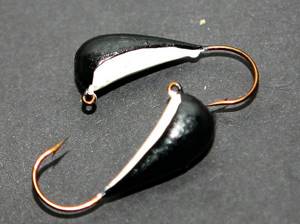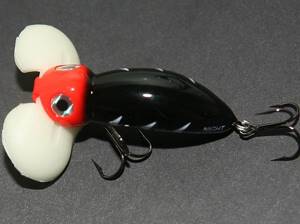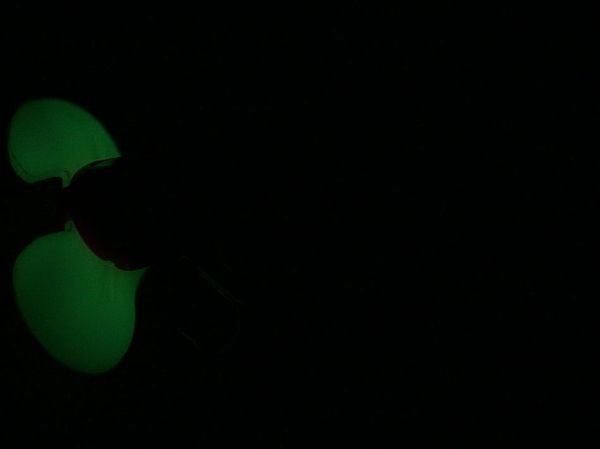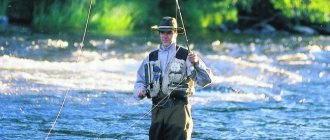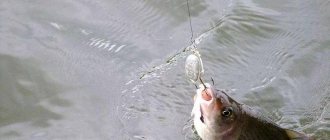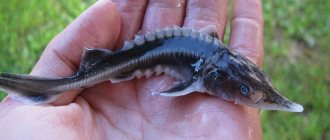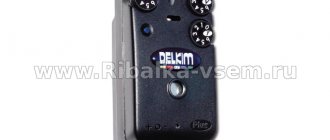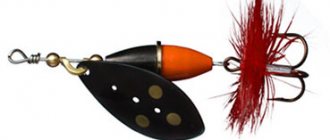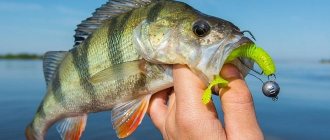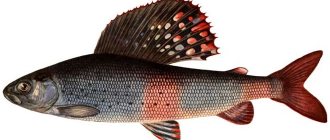The secret of glowing baits
Photo: Evgeny Kuznetsov.
It turned out that with their help the animal is able to see the shadows of other sea creatures and bioluminescent flashes of light.
H.heteropsis lives in the mesopelagic zone - a zone of the ocean located at a depth of 200-1000 meters.
Scientists have suggested that the squid's large eye is designed to detect prey or predators that swim above, and therefore their shadows are visible against the background of daylight penetrating the water column.
The other eye evolved in such a way that the animal could distinguish dim flashes in the depths devoid of light.
It would seem that what does the fish have to do with it? But as I continued my search to answer this question, I found many interesting facts and personal discoveries. There are baits that have effective properties for fishing in the twilight, at night and at depth. Light-emitting materials of artificial origin can now satisfy the demands of fishermen.
Read the material “Why do you need a collimator?”
There are several materials that allow you to make your own spectacular fishing devices that burn brightly in the dark.
Photoluminescent enamel of two components. It is applied with a brush to the bait in 2 layers, and with a spray gun in 3 layers. Drying time is at least 2.5 hours.
Elastic luminous silicone is resistant to moisture and frost. A liquid composite that emits light is suitable for both the jig itself and for casting a bright composite bait.
|
| Photo: Evgeny Kuznetsov. |
|
| Photo: Evgeny Kuznetsov. |
Before fishing, you need to charge your baits with light. During the day, the sun's energy is enough, but at night you need a flashlight. There are nuances - the lower the power of the light source, the longer it takes to accumulate light. The bait will have to be irradiated every half hour. At the same time, the glow should not be bright, it can scare away the fish.
How do luminous baits affect fish? This issue has not been fully studied even by ichthyologists. There are more white territories here than ready-made answers. Because only those issues for which funds were allocated were studied.
First of all, this is the industrial fishing of sea fish, squid and devices that emit light, effectively affecting underwater inhabitants. Suffice it to recall the anglerfish, which uses a luminous bait at the end of its outgrowth to lure its food. Works!
Many inhabitants are not indifferent to light and luminous elements: salmon, halibut, cod, catfish, haddock, perch, smelt, etc. But now, after testing by amateur fishermen, as it turned out, river fish are not indifferent to light and its elements.
Read the material “Salmon fishing: how it was done before”
Ichthyologists say that the vision of pike perch is special. The retina contains guanine tapetum lucidum, a light-reflecting pigment that increases the sensitivity of the retina several times. It also creates the effect of glowing eyes. By reflecting light back, this pigment once again excites the visual cells, allowing you to see in almost complete darkness and at depth.
At great depths, the illumination, even on a clear day, remains at the level of deep twilight. It is precisely this intensity at which pike perch, due to its unique vision, has the greatest advantages over other fish. Which explains the successful fishing of pike perch using luminous baits at night.
It is enough to use a large jig with a nozzle made of sprat or cut fish, but at the same time painted with a light-accumulating material.
Burbot is a well-known nocturnal predator, not very agile. It is at night that he searches every corner of the reservoir, finds small fish that hide at the bottom, between the stones and devours them. This cod brother can and should be caught using luminous baits with the addition of sprat or cutting fresh fish with vertical lures or a large jig in winter, as well as with a spinning rod vertically from a boat or from the shore before and after freeze-up.
Cutting fish and sprat during the game leaves a path in the current, and in stagnant water they spread a cloud of fresh blood, which also has a magical effect even on a well-fed predator.
There is an opinion about pike that it does not feed at night. But, as personal experience has shown, these river crocodiles are perfectly caught using luminous baits. What is this natural instinct that forces you to grab any moving luminous object that comes into the fish’s field of vision or a purposeful hunt? I didn't find the answer, but the principle works.
Read the material “Sports fishing for ripples from ice on a light bulb”
Perch is caught along the way when fishing for pike. But in winter it is better to use a luminous drop pendant on a tee, arming a balancer or spinner with this ball that burns in the dark.
In summer, in the evening and at night, small spinners are good for perch, in front of which hang a small garland of small light-accumulating baits - twisters or flies with luminous beads.
Catching lenok and taimen is practiced in Siberia and the Far East at night using an artificial mouse. But if you use an Arbogast crawler with light-accumulating blades, your fishing will be more effective.
|
| Photo: Evgeny Kuznetsov. |
|
| Photo: Evgeny Kuznetsov. |
Winter has not yet given up its rights to its successor, so there is time to quench its passion on the ice.
Evgeny Kuznetsov March 25, 2021 at 05:18
Lures and ultraviolet
Let's imagine that you are a novice angler and want to start fishing with a spinning rod. Let’s also imagine that you already have a assembled set of gear and you are at the stage of choosing the baits you are going to fish with. Most likely, these will be some kind of wobblers.
You come to the store and talk to consultants. They help you make a choice of baits by asking leading questions: “What kind of fish are you going for?”, “What is your test?”, “What body of water will you be fishing on?” etc. Based on your answers, the consultant can offer you options based on his personal experience. But, often, to save time, they may answer you something like: “Here, this will suit, pike loves this color, and it matches your test, it should work...”. In reality, everything may not be so simple.
This property of lures, such as color, has a number of features that you need to know and take into account when choosing in a store, or when you are going fishing.
Nowadays they make a lot of beautiful baits and often fishermen buy those that they like in appearance. But do fish see these baits so beautiful and colorful in muddy water or, for example, at a depth where not the whole world can reach? No. Of course, if there is not a cloud in the sky, the water is clear and the fishing spot is directly under the open sun, then the fish will see the bait. Although often the opposite is true: it’s getting dark or it’s raining, or the sun is covered by clouds, and the water is cloudy. How can you avoid making a mistake when choosing?
Manufacturers are solving the problem of low light underwater by using fluorescent paints. Such paints glow in ultraviolet radiation. They are used specifically because ultraviolet light (UV-A) penetrates water in sufficient quantities to a certain depth, and fish are sensitive to it. You can read more here: rybak-rybaka.ru/a…/99/19506/
When choosing a wobbler, you need to consider how deep it is. The deeper a wobbler can go under water, the less UV rays will reach it. Also, the penetration of ultraviolet radiation is influenced by the properties of the water in the current body of water. We can say that wobblers with fluorescent coloring are clearly visible in “any” weather at a depth of about 2 m. If the depth increases, then they begin to “fade”. It turns out that for fishing at depths of 4 m or more, it is worth choosing a wobbler, most of which is painted with fluorescent paints. Such baits somehow develop their color at great depths. This is an additional increase in the chances of good bites.

Wobblers under normal lighting and ultraviolet light
What if we are talking about winter fishing? You drill a hole and only through it most of the light passes, since thick ice almost does not transmit the rays of the sun. If you fish with a balancer, then the situation is the same as with wobblers, but if you prefer jigs, fluorescent ones have a better chance of attracting fish!
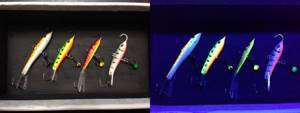
Balancers under normal and ultraviolet lighting
Alas, personally, none of my jigs light up, so I’m going to buy the “right” ones as soon as possible.
If you want to use silicone baits, they can also have the property of “glowing” in ultraviolet light. I give greater preference to silicone with this property.
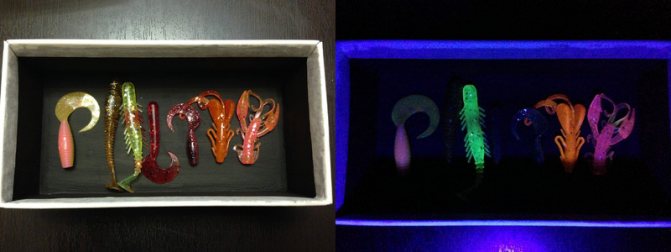
Edible silicone baits under normal and ultraviolet lighting
Based on everything described above, it is worth having a UV flashlight or lamp in your fishing arsenal. There are cheap flashlights for checking banknotes - ru.aliexpress.com...99565.html. It is best to shine light on baits in a dark room, but you can make a special box, the bottom and inner walls of which should be black. In such a box it is convenient to shine through the bait with an ultraviolet flashlight.
If you have already purchased wobblers or other baits, then do not be discouraged if many of them do not glow in ultraviolet light. Just use them at shallow depths up to 1.5-2m on sunny days. And if you have the opportunity to fish in a reservoir with very clear water, then you shouldn’t worry at all.
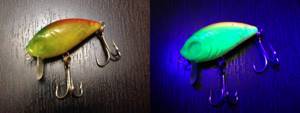
My friend’s most catchy wobbler glows entirely. He was bitten by the fish so much that a third of his paint has already faded, and his eyes have long fallen off, but he continues to fish. Bought at a stall for 40 rubles...
I would like to note that now you should not buy only such baits. They do not provide a 100% chance of a bite. The fish may be “not in the mood” or scared of a bright spot. Manufacturers also make lures that only have thin stripes on the back or small dots that glow. You need to have a rich arsenal so that you have a choice based on the situation. I believe that you need to start fishing with “dull” wobblers and, if there are no bites, switch to baits with a partial glow, and only then use fully fluorescent ones.
